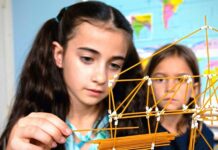Learning colors can be a complicated process. First, you have to learn that different colors are different and that sometimes a given color doesn’t always look the same. Then, you start to learn that these colors have names and that these names are tricky to recognize at first and they might be even harder to say. As your toddler starts on this fun, complicated process of learning their colors, you can help them on their journey by incorporating educational games into their daily routine and by giving them multiple opportunities to expand their awareness of and interaction with different colors.
Why are Educational Games One of the Best Ways for Toddlers to Learn?
Playing and learning are natural activities for toddlers. Every time they play, multiple different areas of development are being accessed. Games and unstructured play are fantastic ways to teach your child or toddler how to identify colors and, later on, how to name colors. This is because every educational game has secondary and tertiary skills that they are learning beyond the direct focus. This is particularly true with games that have physical activity: children love to move around, and giving them a focus for that movement makes learning more fun.
Playing is also about exploration. Whether your toddler likes to chatter, to run around, or to play with their hands, the consistent element of enjoyment helps foster learning and curiosity so they continue to build up their color recognition and color vocabulary.
The Best Educational Games for Learning Colors:
Sorting Games
When your toddler is just beginning to differentiate based on color, sorting games with blocks, different toys, and even food help them start to categorize and build schema around different colors. It’s also a fun, tactile activity; anytime a child can pick up and investigate something, the combination of sensory input makes learning easier and more vivid.
At first, sorting games are best with just a few colors all in the same shade. For example, you can create a fun game with your toddler’s plastic blocks by having them group together all of the different colors. Because they have a uniform shape and do not have differences in shade, they are an excellent first choice to help your toddler identify basic colors. Once your toddler becomes more familiar with sorting the starkly different colors, then they’re ready to start sorting and grouping together materials that come in slightly different versions of the same color such as different red, yellow, and blue things around the house that vary from light to bright to dark. You can help increase your child’s understanding of different colors by gradually exposing them to objects that are trickier and trickier to sort.
Color Hopping
Create a path with different colors of construction paper and play a game where your child hops from color to color while shouting out the name of a color they’re jumping on. Not only does the game teach you child recognition of different colors, but it reinforces memory by having them independently generate the name of the color. Because you’re the one creating the path, you can start off with two to three basic colors and then gradually increase the game to include all of the colors of the rainbow. It’s also a great way to increase physical activity, and studies have shown that increased movement helps brains remember better.
I Spy
I Spy is one of the best educational games for toddlers and young children for many different reasons. Not only does it increase their recognition of different colors around them, it increases their vocabulary and focus on the details of different things. Because it’s a verbal game that takes turns, it’s a great way for your child to both listen to the color name and continue to associate them with the right color. It will also help them independently find and describe everyday objects that come in multiple different shapes and shades.
Educational Games Make Learning Fun and Fast!
Any time you can make learning fun and fast, you’re both increasing your child’s retention of the subject matter and their excitement to learn. Toddlers develop quickly, and creating games that can advance along with them is a great way to spend time with them and give them the tools they need to keep learning. If you want to find more lists for top teaching activities and parenting advice, browse our site here.

















